Jul 31
Posted: under Plantlife, Wildlife.
Tags: beauty, native plants, observation, photography, Weather July 31st, 2010
Significant rain in July is uncommon, and we picked up inches and inches–after the very dry spring and early summer, this was a relief to us and to everything that lives on the place. Switchgrass head-high in July [...more]
Significant rain in July is uncommon, and we picked up inches and inches–after the very dry spring and early summer, this was a relief to us and to everything that lives on the place.
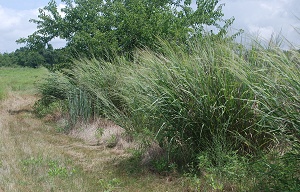 Switchgrass head-high in July
Switchgrass head-high in July
Read the rest of this entry »

Jul 01
Posted: under photography, Plantlife, Water, Wildlife.
Tags: Animal behavior, beauty, dragonfly, insect, observation, odonates, photography July 1st, 2010
When I went out yesterday about noon, I found four of these lovely pink waterlily flowers open: [...more]
When I went out yesterday about noon, I found four of these lovely pink waterlily flowers open:
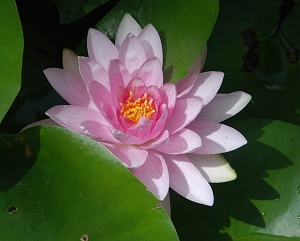 Read the rest of this entry »
Read the rest of this entry »

Jun 06
Posted: under photography, Plantlife, Wildlife.
Tags: beauty, butterflies, insect, photography, prairie restoration June 6th, 2010
A few pictures from a week ago, May 30, and also from yesterday, June 5, as what’s blooming and in what abundance changes rapidly–especially in the hot, dry weather we’re having. (We did get 3/10 of an inch of rain. It barely wet the ground.) Variegated Fritillary, Euptoita claudia, on Gaillardia [...more]
A few pictures from a week ago, May 30, and also from yesterday, June 5, as what’s blooming and in what abundance changes rapidly–especially in the hot, dry weather we’re having. (We did get 3/10 of an inch of rain. It barely wet the ground.)
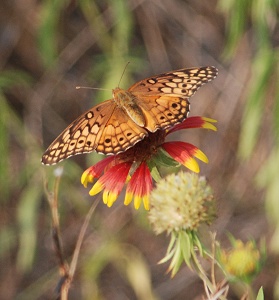 Variegated Fritillary, Euptoita claudia, on Gaillardia
Variegated Fritillary, Euptoita claudia, on Gaillardia
Read the rest of this entry »

May 29
Posted: under photography, Plantlife.
Tags: beauty, native plants, photography, prairie restoration May 29th, 2010
Near Meadow: Claspleaf Coneflower and Lemon Horsemint [...more]
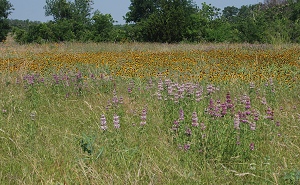 Near Meadow: Claspleaf Coneflower and Lemon Horsemint
Near Meadow: Claspleaf Coneflower and Lemon Horsemint
Read the rest of this entry »

May 28
Posted: under photography, Plantlife, Wildlife.
Tags: beauty, beetle, butterflies, photography, prairie restoration May 28th, 2010
The basketflower, Centaurea americana, looks much like a thistle at first…but the stem and leaves are not prickly at all. It’s a favorite of Black Swallowtail butterflies (and Giant Swallowtails, if there’s enough moisture for the flowers to last into summer) and many smaller butterflies. And also other insects. Beetle flying toward Basketflower already occupied […] [...more]
The basketflower, Centaurea americana, looks much like a thistle at first…but the stem and leaves are not prickly at all. It’s a favorite of Black Swallowtail butterflies (and Giant Swallowtails, if there’s enough moisture for the flowers to last into summer) and many smaller butterflies. And also other insects.
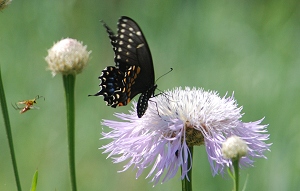 Beetle flying toward Basketflower already occupied by Black Swallowtail
Beetle flying toward Basketflower already occupied by Black Swallowtail
Read the rest of this entry »

May 10
Posted: under Activities, photography, Plantlife, Wildlife.
Tags: Activities, Animal behavior, beauty, butterflies, identification, insect, native plants, new species, photography, wildlife management May 10th, 2010
Because of time constraints (working on copy edits for new book) and weather, the brief walk on the land Saturday didn’t produce any usable bird pictures and I didn’t see any snakes or lizards, but I did see wildlife, large and small: [...more]
Because of time constraints (working on copy edits for new book) and weather, the brief walk on the land Saturday didn’t produce any usable bird pictures and I didn’t see any snakes or lizards, but I did see wildlife, large and small:
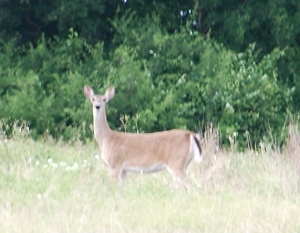 Read the rest of this entry »
Read the rest of this entry »

May 02
Posted: under Activities, photography, Plantlife, Wildlife.
Tags: Activities, beauty, native plants, water resource management, wildlife management May 2nd, 2010
We’re already drying up, though much is still green and flowers are still blooming…the long-range forecast is for a “mild drought.” Last summer, in the worst of the drought, we reworked the backyard water feature (which had become overgrown with water irises, among other things.) We started it before we had the 80 acres, designing […] [...more]
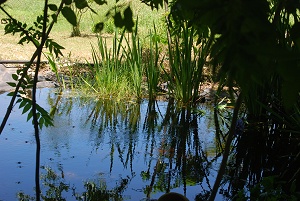
We’re already drying up, though much is still green and flowers are still blooming…the long-range forecast is for a “mild drought.” Last summer, in the worst of the drought, we reworked the backyard water feature (which had become overgrown with water irises, among other things.) We started it before we had the 80 acres, designing it for wildlife use from the beginning, with sunny, shady, quiet, and fast-moving sections of varying depths and shapes. In the extreme drought that ended last fall, it was crucial to our wildlife, because neither of the small guzzlers out on the 80 acres was big enough to sustain a good population of amphibians or odonates.
Read the rest of this entry »

Apr 28
Posted: under photography, Plantlife, Wildlife.
Tags: beauty, butterflies, native plants, photography, seasons April 28th, 2010
Engelmann’s Daisy, one of the old native prairie plants that cattle love to eat. We’re trying to get it established again–so far, in a protected location: [...more]
Engelmann’s Daisy, one of the old native prairie plants that cattle love to eat. We’re trying to get it established again–so far, in a protected location:
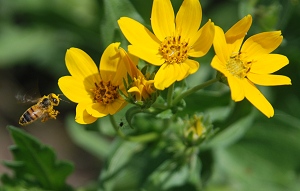
Read the rest of this entry »

Apr 27
Posted: under photography, Plantlife.
Tags: beauty, native plants, photography April 27th, 2010
The end of a drought brings amazing flower displays–both in variety and in number. Here are a few of our beauties, up close: [...more]
The end of a drought brings amazing flower displays–both in variety and in number. Here are a few of our beauties, up close:
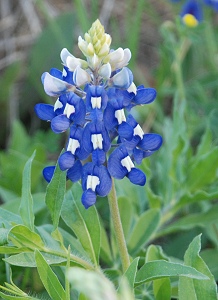 Read the rest of this entry »
Read the rest of this entry »

Apr 11
Posted: under photography, Plantlife.
Tags: beauty, native plants, photography April 11th, 2010
Along the fencerows and in the creek bottoms at this time of year, you’ll see sudden puffs of white on shrubs that range from waist high up to about 15 feet. The first white-flowering shrubs–with discrete “powderpuff” flowers–are Rusty Blackhaw Viburnum, Viburnum rufidulum, a native here which is being destroyed by development. That’s because developers […] [...more]
Along the fencerows and in the creek bottoms at this time of year, you’ll see sudden puffs of white on shrubs that range from waist high up to about 15 feet. The first white-flowering shrubs–with discrete “powderpuff” flowers–are Rusty Blackhaw Viburnum, Viburnum rufidulum, a native here which is being destroyed by development. That’s because developers and land managers think of anything but large oaks as “brush” to be cleared away.
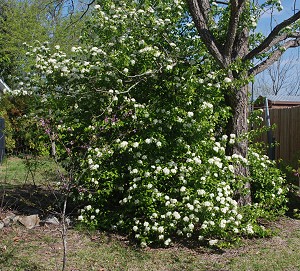 Read the rest of this entry »
Read the rest of this entry »











